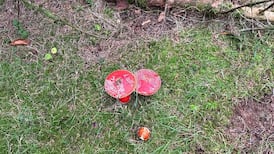A day-long blast from the mountain stripped the big willow of most of its leaves, leaving the garden path prettily patterned with lemony dashes and arcs. Ash and sycamore, too, were shredded, but the oaks take longer to loose their grip, not least of the strange fruit that adorn their topmost twigs.
These are clusters of hard, woody marbles, now green but turning brown, known as oak galls. They are conjured from the tree’s tissues at the prompting of larvae of minuscule Cynipid wasps, which lay their eggs in summer in the trees’ flowers or buds. Cut a gall in half and there at its centre is this squidgy little grub whose chewing induced the tree to make a tough little ball in which to spend the winter.
Still marvellously mysterious in their biochemical triggers, the galls on plants – swellings of various sizes and kinds in which their young feed and grow safely, emerging in the spring – are created by a huge range of insects. Aphids, midges, thrips and sawflies are among 13,000 or so species that do it, often picking on particular kinds of plant. The most striking and bizarre wasp galls are those sometimes seen on branches of the wild dog rose – big, bristly growths in bright pink, or Robin’s pincushions in one folk name.
What fascinates me about our marbles, to begin with, is the long and varied usefulness of oak galls to people. Their tannic acid has helped process skin into leather, dye cloth black and make indelible ink for manuscripts – even, in modern times, for the banknotes of dollars and pounds sterling.
The galls of native oaks in these islands, however, held only a third as much tannin as oak species in the Middle East, notably the small, so-called Aleppo oak, Quercus infectoria. Its dark and heavy galls were imported to England in large quantities, starting in 1830. And with them came alien Cynipid wasps, of which our marble gall wasp, Andricus kollari, was one. That it spread across to Co Mayo was no surprise: these tiny insects are easily borne on the wind, and some 40 Cynipid species have been recorded as new to Ireland.
Among them is Andricus quercuscalicis, the one Cynipid wasp whose gall-formation does real damage to native oaks. Its galls invade acorns as they grow, distorting them to weird and infertile shapes, somewhat like the bare kernels of walnuts. These are "knopper galls", and their sudden appearance on pedunculate oaks in the Phoenix Park in the 1990s confirmed the wasp's presence in Ireland.
That leads to another complexity in the lives of Cynipid wasps: most of them need not one tree but two to complete their life cycle. The knopper galls on pedunculate oaks, Quercus robur, the bigger of Ireland's two native oaks, produce only female wasps, which go on to lay their eggs on the catkins of the Turkey oak, Quercus cerris. From these small, conical galls emerge a male and female generation that mate to lay eggs on the pedunculate oaks.
The knopper gall wasp, therefore, needed both these kinds of oak for survival in Britain and Ireland. The Turkey oak was widely established on both islands as specimens on big estates and a generous habit of keeping their distinctive, deeply lobed leaves well into winter.
Since a rather eccentric order to fell them at some British ministry of defence bases, ecologists in Scotland have found that the wasps make a valuable meal for nesting tits at the start of today's earlier springs.
Noble specimens
Just how impressive the oaks can be is borne out by the noble specimens of Co Kilkenny featured in Heritage Trees of Ireland (Collins Press, €29.99), a large-format book to be launched next week by the Tree Council of Ireland. With text by Aubrey Fennell and splendid photographs by Carsten Krieger and Kevin Hutchinson, this is probably the finest gallery of Irish trees there is ever likely to be.
They were tracked down for the Tree Council over 15 years by Fennell, whose career as a tree surgeon was truncated when he dropped a large one on to “an expensive parked car in Ballsbridge”. His choices for the book pay due homage to the greatest oaks, tallest pines, most ancient yews and arresting exotics but also show an eager feeling for native trees special to local interest and affection.
His 150 specimens thus find space for significant hawthorns, dancing ashes, historic survivors and unabashed curiosities such as the Grasping Birch of Sandyford, perched on a stump in an industrial estate. There is lively humour here, and great love and perseverance in securing the stories of individual trees. Their portraits are given great presence and beauty in this remarkably affordable book, sponsored by the Kerry Group – the Christmas present, indeed, for any lover of trees.










